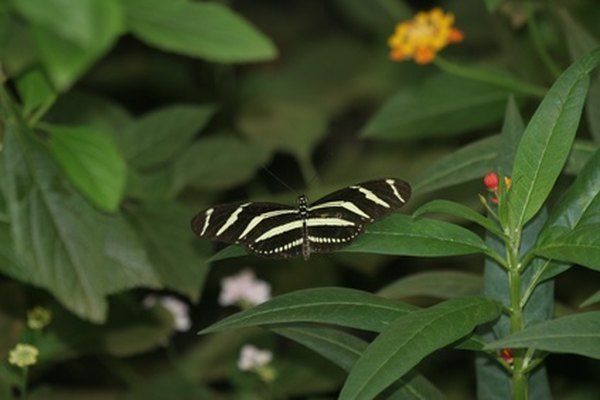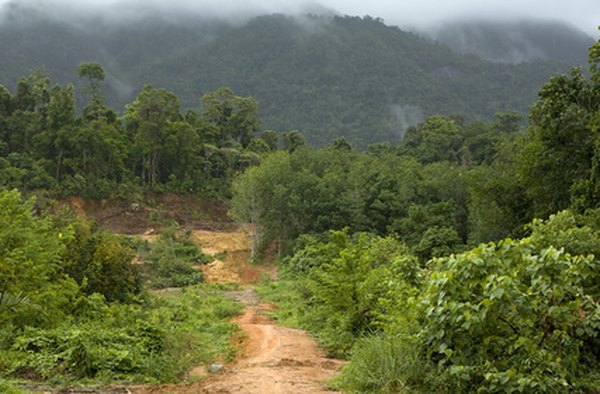What Are Two Things Animals And Plants Need In The Tropical Rainforest
The climate within rain forests is warm, with much rain through most of the twelvemonth, which makes the landscape responsive to animal and plant interaction. Rain forests are dwelling house to a large number of constitute and fauna species. A variety of animals, birds and insects subsist together in adaptive surroundings. The plants, shrubs, flowers and streams provide nutrient and drink for the animals. Microbial activity and mixed mulch enrich the soil, thereby promoting healthy constitute growth.
Pelting Forests--a Blend of Numerous Groups

••• green python snake image past MAXFX from <a href='http://www.fotolia.com'>Fotolia.com</a>
Scientists believe that the tropical pelting forests of the globe might hold upwardly to 90 percent of the plant and brute species on earth, according to the sps.lane.edu online article Tropical Rainforest Biome: Rain 3.
The Amazon River feeds the world's largest tropical pelting wood. There are approximately iii,000 species of fish in the river. The Pelting 3 article states that a typical patch of rain forest measuring half dozen kilometers foursquare contains equally many as 1,500 species of flowering plants, 750 species of trees, 400 species of birds, 150 species of butterflies, 100 species of reptiles and sixty species of amphibians. A 2.5-acre of the rain forest may contain as many as 42,000 species of insects, co-ordinate to the Biome article.
Pelting Forests Animal Security
Sensible nonverbal advice exists in the pelting forests as smaller animals use the cover of plants for security and accommodate to their surroundings. Since the woods is strewn with dead leaves, some animals use the leaves to finer cover-up themselves confronting predatory animals searching for food. Moths, tree frogs and katydids, or long-horned grasshoppers, alloy into the environment at will and become invisible.
Animals of the pelting forests employ brilliant coloring to warn predators that they are poisonous; still, in some cases, this move is simply a ruse to stay live. Toxicant arrow frogs are colorful and truly poisonous. Some indigenous pelting forest tribes utilise the poisonous secretion from the frogs to poisonous substance the tips of their blowgun darts equally they hunt for food in the woods.
Vegetation and Animals

••• gorilla dejeuner image by Mat Hayward from <a href='http://www.fotolia.com'>Fotolia.com</a>
Vegetation is a abiding presence in the rain wood. River tributaries running throughout the forest floor also collect h2o and serve as watering holes for animals. The rain runoff from trees provides a rich source of nutrition for trees and shrubs. Animals obtain nutrition from flowering trees and shrubs that bear seeds and fruits.
Smaller animals build their nests in thick overgrowth of thickets. Copious leaves on the forest floor combined with rainwater and microbial action provide mulch to the soil. Found growth is lush, and food supply for animals is abundant.
Animal and Plant Life--a Shared Culture

••• rainforest butterfly epitome by michael luckett from <a href='http://world wide web.fotolia.com'>Fotolia.com</a>
The Amazon River basin's rain forest contains a wider multifariousness of plant and creature life than any other biome in the globe, according to blueplanetbiomes.org. The online article "Animal Life" affirms that mutual characteristics found amidst mammals, reptiles, amphibians and birds in that biome include adaptations to a life in the trees. Other characteristics, it states, are bright colors and sharp patterns, loud vocalizations, and diets heavy on fruits from pelting wood trees.
Animals and Plants Are Mutually Dependent

••• rainforest image by Aleksander from <a href='http://www.fotolia.com'>Fotolia.com</a>
The lives of animals and plants are intertwined. The decline of one species creates a marked reduction for the other. Rainforest Biomes state that thousands of years of heavy rains have washed away the nutrients of rain forests. Nutrients in rain forests are establish mainly in living plants and the layers of decomposing leaves on the forest flooring.
Various species of decomposers, such as insects, bacteria and fungi, convert expressionless constitute and animate being thing into nutrients, according to Rainforest Biomes. Plants then blot these nutrients, which promote tree growth to produce fruits and seeds in addition to leaves for the animals' diets.
Source: https://sciencing.com/plants-animals-interact-rain-forest-6672736.html
Posted by: readersaineve1964.blogspot.com

0 Response to "What Are Two Things Animals And Plants Need In The Tropical Rainforest"
Post a Comment